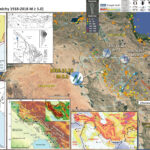This morning (my time) there was a possibly shallow earthquake in western Iran with a magnitude of M = 6.3. This earthquake occurred in the aftershock zone of the 2017.11.12 M 7.3 earthquake. Here is my report for the M…
Earthquake Report: Mid Atlantic Ridge
There was a M = 6.8 earthquake along a transform fault connecting segments of the Mid Atlantic Ridge recently. (now an M 6.7) https://earthquake.usgs.gov/earthquakes/eventpage/us1000hpim/executive The Mid Atlantic Ridge is an extensional plate boundary called an oceanic spreading ridge. Oceanic crust…


